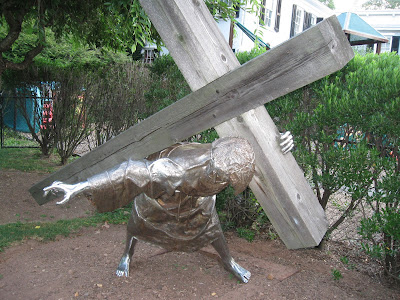For two thousand years Christians have pondered the old story. One came from heaven to earth. Born like us. Grew up like us. Struggled like us. And even died like we all finally will. And that last week of Jesus’ life became the focus of so much of what Christians through the ages have believed. This would be the story that they would retell and sing and preach and dream and act out again and again. All four gospels testify that to the saga where Jesus setting his face to go to Jerusalem for the last time. They called it The Way: Via Dolorosa: the way of sorrows. And through that winding way believers would discover a redemption for themselves and for the whole world.
They sang it and preached it and carved it and sculpted it. “Lamb of God that takes away the sin of the world, have mercy upon us.” That story of the last week in Jesus’ life would weave its way into the heart of all they did. Early pilgrims would make their way to those special places where they had been told it all began. In time, they called it the Holy Land.
But many could not get to the Holy Land. Travel was difficult or impossible. Those returning would tell the story of what they had seen and felt in those special holy places. By the 15th century they named these places The Way of the Cross. These were stations, stopping places where believers would follow the footsteps of Jesus to the cross.
Churches began to bring these holy places to their own parishes and cemeteries and parks. In Bologna, there were five stops in the church that pilgrims could make. In Antwept there were seven. Sometimes there were as many as twenty or thirty. William Wey, an Englishman called these special shrines stations. Go into any Catholic church in the world today and you will find the stations—where pilgrims are still drawn.
By 1857 the church had pared down the list of stations to 14. Sometimes a fifteenth station is added to represent the Resurrection. But, especially during Holy Week Christians have gathered and moved from station to station pondering the mystery of Christ’s sufferings.
And so, during this Lenten season I am going to begin my own journey with the Stations of the Cross—and I ask you to join me. I first was captured by the stations in the garden outside the Thomas Aquinas Institute in Princeton, New Jersey. They have erected the fourteen different stations outside, under the trees, by some artist. I do not know the artist's name but I do know if you wander down Stockton Street in Princeton go through the entrance circling their building you will find the stations. I have taken pictures of these stations. These will form the focus of our meditations during this Lenten season. Tomorrow we begin our journey at the first station.
(This moving sculptured piece is found on the grounds of Trinity Episcopal Church on Mercer Street Street in Princeton, New Jersey. I have been unable to find the artist's name.)



I remember spending some time visiting this Jesus. I also remember preaching a sermon about this work of art. Terry Raines had taken a photo of it, and he made copies for each worship bulletin. I don't believe about Jesus now what I believe about Jesus then. Hey...maybe that's blog post title! Thanks...
ReplyDelete